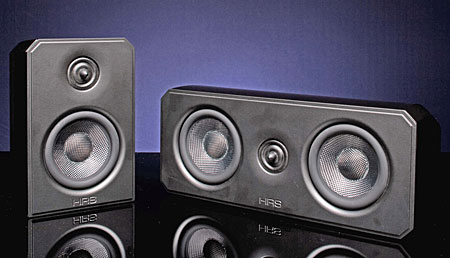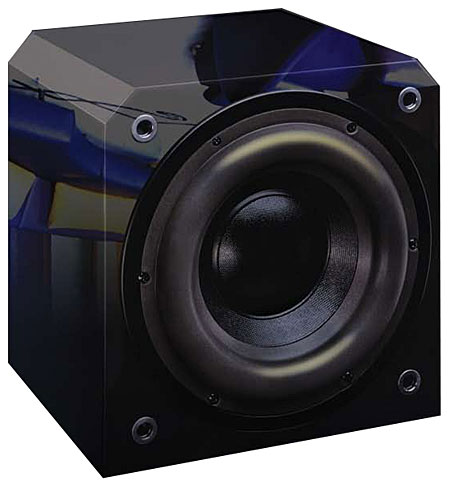Sunfire HRS Speaker System

That was then—this is now. Significant improvements in drivers, construction materials, and speaker enclosures have turned this assumption upside down. Smaller satellite/subwoofer systems with excellent performance are often preferred to floorstanding speakers because many homeowners want more discreet speakers that produce a satisfying, powerful sound yet blend more subtly with their decor.
Sunfire is one manufacturer that is seizing this trend. Following the release of its Cinema Ribbon line of home-theater speakers, Sunfire has introduced the High Resolution Series of satellite speakers and subwoofers with many of the performance characteristics of the Cinema Ribbons at a more affordable price.
The HRS line began with the Sunfire HRS subwoofers, which are known for their ability to produce prodigious amounts of bass from a very small box. I can validate their claim—I have tested the HRS-8 in my 23x16-foot listening room with quite satisfactory results. This little dynamo, an 8-inch cube-shaped subwoofer with a built-in 1000-watt amp, filled my listening room with solid bass, although the 10-inch or 12-inch model would certainly provide more impact for heavy home-theater use.
For this review, I tested four HRS SAT4 satellites, a HRS SAT4C center-channel speaker, and two HRS-10 subwoofers in a 5.2-channel configuration.
Features
The HRS SAT4 satellites measure just eight inches tall and a little over five inches wide with a slight front-to-back curvature on the sides. The stylish high-gloss black enclosures are acoustically sealed and utilize a single 4.5-inch Kevlar woofer and a 1-inch ring-radiating tweeter. The woofers are mounted to the rear of a cast-aluminum baffle and clamped to the enclosure rather than attached to the front, which results in a stiffer, more rigid cabinet and a cleaner look with no screws on the front of the baffle.
The speaker's voice coil is a triple dual-layer design. Easy explanation: The dual-layer, copper-clad aluminum voice-coil wire is wound in three concentric layers, which delivers more current to the voice coil (80% more, according to Sunfire) and enhances the speaker's power-handling and dynamic-range capabilities.
The woofers exhibit high back-EMF, which produces quicker, tighter midbass response. Simply stated, back-EMF (electromotive force) is an equal-but-opposite electrical force generated by the speaker's voice coil as it is driven by the amplifier. In the same way the amp's output powers the speaker, back-EMF counteracts the amp's electrical force, resulting in less "ringing" or "overshoot" and improved damping of the driver. When properly designed, the effect is tighter midbass response. All speakers have some level of back-EMF, so the enclosure volume must be optimized to take advantage of it.

The HRS SAT4C center-channel speaker uses two 4.5-inch drivers and a 1-inch ring-radiating tweeter configured in a D'Appolito array for improved dialog intelligibility and sound localization. It includes a "kick-stand" to tilt the speaker up or down toward the listening area depending on whether it's placed above or below the video display.
All HRS speakers are magnetically shielded for placement close to a CRT television. However, I quickly discovered that the grilles are not magnetically shielded! The magnets that attach the grille to the center-channel speaker were strong enough to distort the picture when placed on top of my CRT. This may not matter when the speakers are wall-mounted or used with a plasma or LCD display.
The satellites can be placed on a shelf or stand, or they can be wall-mounted with the keyhole mounts on the rear of the cabinets. Sunfire offers optional matching speaker stands with an integrated wire channel to conceal the speaker wire for a neat installation. Using bare wire with the speaker stands is easier than spade lugs. I had some difficulty using my high-performance speaker cables because the cable must bend more than 90 degrees at the top of the stand to connect to the binding posts on the back of the speaker.
The HRS-10 subwoofer utilizes a 10-inch woofer with high back-EMF and an oversized rubber surround to permit extra-long excursion. The long-throw design is necessary because a subwoofer needs to move a lot of air, and the HRS-10 is a very compact cube measuring only 11.5 inches in each dimension.
The sub provides line-level and speaker-level inputs, line-level highpass outputs, a phase control, a crossover-frequency control with bypass, and a volume control. An automatic signal-sensing circuit detects an audio signal and activates the subwoofer as needed.
The HRS-10 is powered by what Sunfire calls a Tracking Downconverter Amplifier that pumps out 1000 watts. The Tracking Downconverter is a proprietary circuit that keeps the amplifier idling at 6 volts above ground, pre-conditioning it for an incoming audio signal. This is like coming to a rolling stop at an intersection—if you don't stop completely, less energy is required to return to highway speed. Since the amplifier is idling at 6 volts above ground and not completely off, it can respond more quickly to music transients. The HRS-10 also features a signal compressor with a "soft-clipping" circuit that kicks in if the input signal could overload the woofer and cause damage.
- Log in or register to post comments




































































